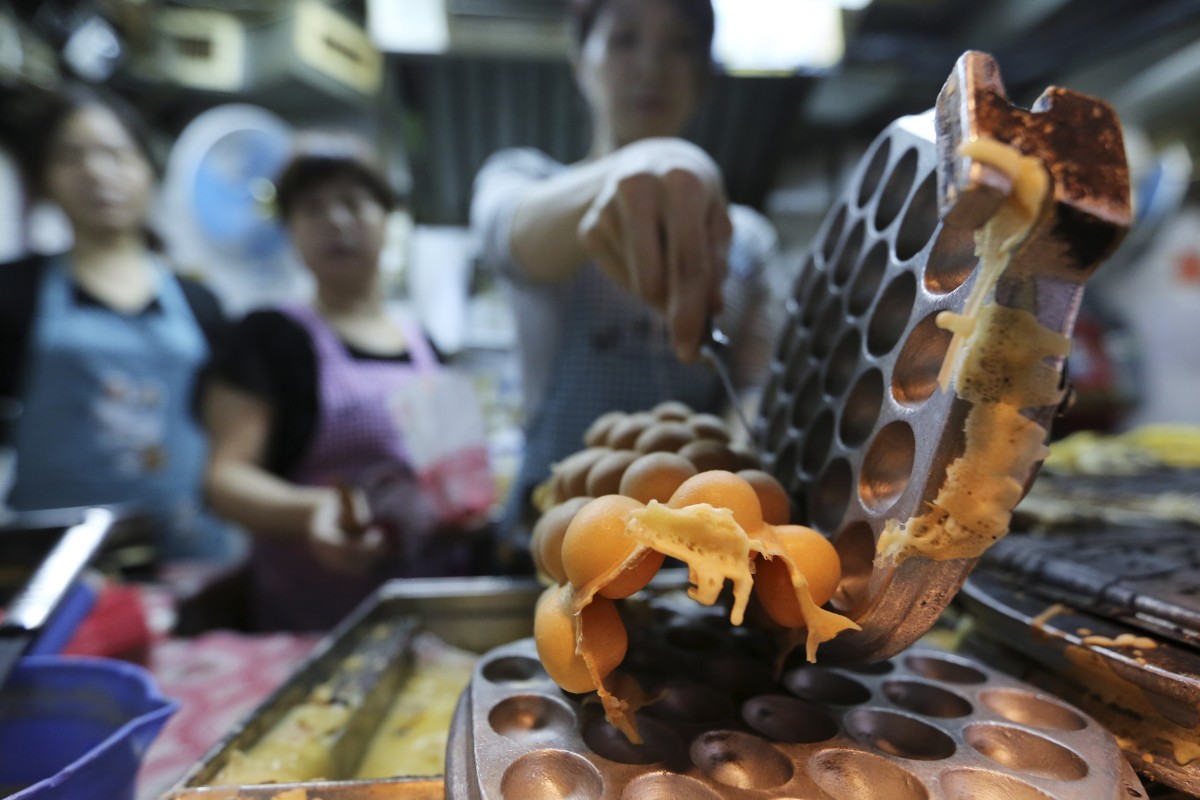
Egg waffles: the history of Hong Kong’s favourite street snack and a nutritionist’s recipe for a healthier version
- This iconic street food first appeared in the city in the 1950s as an affordable and portable treat
- Every week, Talking Points gives you a worksheet to practise your reading comprehension with questions and exercises about the story we’ve written
 Egg waffles, also called ‘gai daan jai’, have a rich history in Hong Kong. Photo: SCMP
Egg waffles, also called ‘gai daan jai’, have a rich history in Hong Kong. Photo: SCMPEgg waffles, eggettes, egg puffs, gai daan jai, bubble waffles – these are just some of the names for this quintessential Hong Kong street snack.
A childhood staple for most locals, egg waffles have seen a surge in popularity around the world. A chain in the city has even been given the Michelin Guide’s thumbs up of approval. Compared to the star treatment it has been getting, the snack actually has more humble beginnings.
A nutritionist’s take on siu mai and curry fish balls
A waffle for the masses
The egg waffle first appeared in the city’s streets in the 1950s as a way to use broken eggs that could not be sold. Instead of tossing them out, these eggs were mixed into a batter with flour, sugar and evaporated milk. It was poured into a waffle iron and cooked over a charcoal flame.
To achieve the waffles’ signature look, the mould was flipped as soon as the batter was poured in. The result was a delicious waffle that was crispy on the outside and soft on the inside.
The enterprising shopkeepers who invented the snack also ensured it was affordable for the masses. The waffle iron created a mass of miniature eggs which could be easily broken apart and bought as individual bubbles.
This snack proved to be so popular that it was soon sold on nearly every street corner in Hong Kong.
The modern egg waffle
These days, most vendors use an electric waffle machine instead of the traditional iron. But the ingredients have not changed much over the years.
The batter is usually a mixture of flour, baking powder, custard powder, eggs, sugar and milk. Fillings can range from the classic to the funky – such as chocolate chips, pork floss, black sesame and salted egg yolk.
How to order street food like a local
In terms of its nutritional value, one egg waffle typically has about 12 grams of fat and 400 calories. To put this in perspective, an egg waffle contains as many calories as one and a half slices of pizza.
Thus, it is best to eat them as an occasional treat and to share them with your friends or family.
But if you happen to have an electric waffle machine tucked away in your kitchen, why not put your cooking skills to the test? Try this recipe for a gai daan jai that has less fat and sugar than what you might find on the streets.
The stories behind the strange names of iconic street snacks
Ingredients (serves 2)
For the dry ingredients, you will need:
-
¾ cup spelt flour
-
1 tablespoon custard powder
-
1½ teaspoon baking powder
For the wet ingredients, you will need:
-
¾ cup cold milk
-
2 large eggs
-
¼ cup monk fruit blend sweetener
-
½ teaspoon vanilla extract
-
50 grams salted butter, melted
You will also need some vegetable oil spray.
Directions
-
Combine all the dry ingredients, and set them aside.
-
Add all the wet ingredients to a blender. Blend until smooth.
-
Add the dry ingredients to the blended wet ingredients. Then, blend the mixture until you can no longer see any bits of flour. It is all right if the mixture is a bit lumpy.
-
Cover the batter with cling film, and place it in the fridge for 30 minutes.
-
Preheat the waffle machine to a medium heat setting. Grease it with vegetable oil spray.
-
Pour about half of the batter into one side of the waffle iron. Close the mould, and hold the handle firmly to prevent the batter from leaking. Then, flip the closed mould so the egg batter fills the other side evenly.
-
Cook for about 4 to 5 minutes or until both sides are golden brown.
-
Remove the waffle carefully, and fold it gently to form a cone shape. Place your waffles on a rack – they will become crispier as they cool.
Enjoy your home-made gai daan jai!
Click here to download a printable worksheet with questions and exercises about this story. Answers are on the second page of the document.
